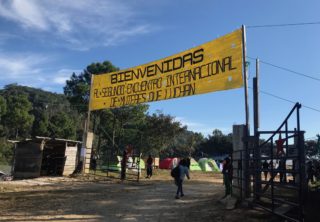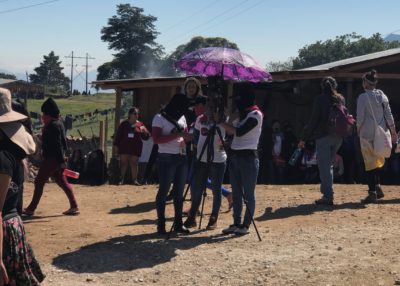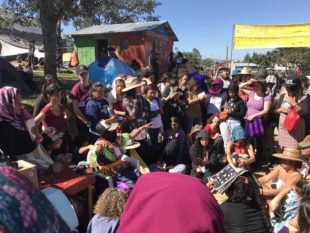 When four thousand women from forty-nine countries met in a Zapatista community to find ways to end violence against women, we knew what we were up against. Many, if not most, of the women brought with them the scars of gender violence. We also knew we were meeting at a critical and contradictory point in the history of women’s movements–a point when an all-time high in public attention and mobilization coincides with a rise in the violence the movements aim to stop.
When four thousand women from forty-nine countries met in a Zapatista community to find ways to end violence against women, we knew what we were up against. Many, if not most, of the women brought with them the scars of gender violence. We also knew we were meeting at a critical and contradictory point in the history of women’s movements–a point when an all-time high in public attention and mobilization coincides with a rise in the violence the movements aim to stop.
The second “Gathering of Women Who Struggle” faced two big questions: how do we take personal pain and forge it into collective action, and what do we need to be doing differently to reduce a form of violence that has proved not only intransigent, but resurgent?
There was no program or set of issues defined beforehand, which made for a loose-knit and sometimes chaotic situation. The first day scores of women stood up to a mike on a wooden platform to describe the abuse they’ve suffered, and the paths they built, collectively, to get out of abusive situations, heal themselves and help others. Their stories demonstrated the degree to which violence against girls and women permeates society and how it has been normalized through socially accepted practices that isolate the victim and her pain. Each woman who spoke was met with a cry of “you are not alone!” That’s an important first step.
The second day participants broke into groups to discuss strategies to deal with the frustrating truth that after decades of identifying, legislating, institutionalizing protection mechanisms and organizing around violence against women, we are no closer to eradicating it. In most of our countries, femicides—the murder of a woman for being a woman—have gone up.
 In El Salvador, murders of women more than doubled between 2013 and 2017, with Honduras and Guatemala close behind. Mexico faces an epidemic in violence against women. The UN reports that nine women are killed every day, and the Mexican Institute of Statistics and Geography found that 44% of women have suffered violence from a partner and 66% have experienced some form of violence.
In El Salvador, murders of women more than doubled between 2013 and 2017, with Honduras and Guatemala close behind. Mexico faces an epidemic in violence against women. The UN reports that nine women are killed every day, and the Mexican Institute of Statistics and Geography found that 44% of women have suffered violence from a partner and 66% have experienced some form of violence.
The statistics don’t reflect the extent of the problem since many cases aren’t reported. Most of the women who told their stories at the Zapatista meeting described a process of years, if not decades, to dare to speak out about the attacks. In many legal systems, women who suffered abuse as young girls can’t report the crime due to statutes of limitations. The stories of the abuse of women as little girls are the hardest to listen to.
The testimonies also bore out the fact that discrimination, racism, homophobia and poverty compound the risk. Native American women in the United States face a murder rate more than 10 times the national average. Undocumented migrant women are increasingly afraid to report violence for fear of deportation, putting them at far greater risk and allowing situations of domestic violence to escalate. An estimated 60% of migrant women who pass through Mexico are raped. Attacks against members of the LGBTQ community have become particularly common and vicious, and women workers face systematic violence that often includes economic blackmail.
At the same time, feminist movements have made great strides in raising the issue. From the #MeToo movements that publicly denounce sexual abuse and harassment, to the Chilean women’s viral performance of “A rapist in your path”, to demonstrations throughout the world, including the current wave of student strikes and occupations against gender violence in Mexico, a new generation of feminists is spearheading organizing to reclaim the right to live without fear, injecting a new anger and urgency in women’s movements, as well as new tensions and challenges.
The opening speech of Zapatista Comandanta Amada reflected the frustration of living in societies where there’s more awareness of women’s rights, but also more violence. “They say that women are now taken into account, but they continue to kill us. They say there are now more laws that protect women, but they continue to kill us,” Amada told the crowd. She criticized apparent progress on women’s issues—toward equal pay, presence in the media, men in the movement, and–as in Mexico’s government–equal representation in government, ending every advance listed with the dictum: “but they continue to kill us.”
The Zapatistas announced that in 2019 not a single woman was murdered or disappeared in their communities, located in the southern Mexican state of Chiapas. As always, they emphasized that theirs is not a model to be applied elsewhere, but a call to organize, in different ways, in different places, toward the goal of eliminating violence against women. Their success reminds us that the fundamental demand to live without the reality-based fear of attack by men is not impossible.
Three Challenges
Comandanta Amada emphasized three issues that constitute major challenges for modern feminisms: the development of an anti-capitalist analysis and practice, the generation gap, and the relationship of women’s movements with governments.
“It seems like our violent deaths, our disappearances, our pain—they all profit the capitalist system. Because the system only allows that which brings it profit. That’s why we say that the capitalist system is patriarchal.” She concluded, “…To fight for our rights, for example, the right to life, it’s not enough that we fight against machismo, patriarchy, or whatever you want to call it. We must also fight against the capitalist system.”
Among the thousands of women at the gathering from all kinds of organizations and collectives, some include anti-capitalism as a central tenet of their work, some do not, and many, probably the majority, seem to consider the capitalist system an abstraction that isn’t particularly relevant to their cultural, social and political feminism. Although the gap that exists between a critique of capitalism and feminisms wasn’t broadly debated at the gathering, the linkage must be understood and deepened, not only in updated feminist theory, but especially in practice. It’s no accident that the anthem of the contemporary feminist movement “A rapist in your path” emerged in the context of the massive movement against neoliberal policies in Chile. A vision of women’s liberation that does not confront the economic model ends up including only women with privilege, and even for them is ultimately doomed to fail.
Second, the Zapatistas issued an explicit call to respect “mujeres de juicio” –“women of judgment, that is, of age”. The reference spoke to a widening gap between younger feminists and older generations that has opened up in the context of recent mobilizations. Unfortunately, it’s not just a gap, it’s a wedge, with misunderstandings on both sides and few spaces for open discussion about the differences. Comandanta Amada ended with an admonishment that must be taken to heart: “If we don’t let geographies divide us, then let’s not let calendars divide us either.”
Third, during the discussions and in the speeches almost no-one emphasized the government’s role in ending violence against women, except to say that it has failed. This is interesting considering that women’s movements have invested a great deal of time, effort and resources into drafting and passing legislation, attempting to improve access to justice and legal procedures, putting abusers behind bars and creating governmental protection mechanisms and programs. The results of all that effort have been alarmingly bad, especially in Mexico. Violence against women continues to rise and most of the attackers continue to face no consequences.
 Even governmental programs that seem to have worked prove to be vulnerable and too-often ephemeral. The 1994 Violence Against Women Act (VAWA) in the United States. has been credited with reducing domestic violence by 60% and yet it was allowed to expire and renovation is currently stalled in Congress. The Republican Senate has refused to renew it because the House passed a strengthened version last spring that broadens a prohibition on the sale of firearms to those convicted of domestic violence. U.S. studies show women are five times more likely to be murdered by men if there is a gun in the house. Similar studies in Mexico and Central American countries where the U.S. exports massive amounts of firearms also show the lethal link between guns and femicide. But apparently, for Republicans in Congress the political clout of the National Rifle Association trumps women’s lives.
Even governmental programs that seem to have worked prove to be vulnerable and too-often ephemeral. The 1994 Violence Against Women Act (VAWA) in the United States. has been credited with reducing domestic violence by 60% and yet it was allowed to expire and renovation is currently stalled in Congress. The Republican Senate has refused to renew it because the House passed a strengthened version last spring that broadens a prohibition on the sale of firearms to those convicted of domestic violence. U.S. studies show women are five times more likely to be murdered by men if there is a gun in the house. Similar studies in Mexico and Central American countries where the U.S. exports massive amounts of firearms also show the lethal link between guns and femicide. But apparently, for Republicans in Congress the political clout of the National Rifle Association trumps women’s lives.
Where rightwing governments come to power—Trump in the United States and Bolsonaro in Brazil come to mind— hard-won protections for women are being rolled back at mind-boggling speed. Even progressive governments, like Mexico’s under president López Obrador who has declared “the end of neoliberalism”, wind up putting women’s rights and safety on the historical back burner. It’s no wonder that proposals from the gathering focused on women’s grassroots organizing and collective self-protection rather than seeking government fixes.
Organizing Among Us
While women practiced self-defense training on the community soccer field, others discussed their work in accompanying women who have to take dangerous routes to and from work, creating “safe spaces”, publicly denouncing abusers, forming brigades to search for women who have been forcibly disappeared, adopting security protocols in their organizations, creating victims’ support groups, developing popular education programs, providing translators for indigenous women, defending migrant women en route, setting up counseling services and all kinds of creative healing therapies, visiting women in prison and providing re-entry services, campaigns for women tourists to prevent abuse and assault in resort areas, performances and street art to raise consciousness, networks of women human rights defenders, fighting for access to land and economic security for rural women, running shelters, sharing basic needs and creating an infinitely wide range of ground-up initiatives.
The idea is to build feminist caring communities that don’t necessarily give up on law enforcement, but take matters into their own hands. For many, the state has lost credibility as a guarantor of basic safety for women. Many groups continue to document and denounce abuses, while at the same time protecting and providing among themselves. Territorial autonomy and self-government, like the Zapatista community where the gathering took place, isn’t a viable goal for women’s organizations in most places, but the development of autonomous practice and grassroots protection has taken deep hold in feminist groups in Mexico and around the world.
The Second Gathering served to energize women and their organizations. For many, it was the first time they had been at an all-women’s gathering (only boys under twelve were allowed, as men were given outside support roles), the first time in an autonomous Zapatista community, the first time talking directly with Zapatista women including those who participated in the 1994 insurrection and those who were born and raised in
in communities governed by the Revolutionary Law on Women. Once again, the international gathering showed the political acumen and convening capacity of the Zapatistas, a central actor in the anti-globalization organizing of the nineties and of the continued resistance of indigenous peoples. It also showed the momentum behind this new wave of the women’s movement, fueled by outrage, the power of a new generation and the capacity to cross traditional barriers between us to build together.
Fighting for Our Lives
Today’s women’s movement aims not only to “take back the streets”, but to take back every nook and cranny where we as women live our lives. To spend three days in an encampment of thousands of women committed to ending violence—without men, without fear—provided an exhilarating glimpse of the freedom we want and need.
As feminists, we know that those battles for nooks and crannies are precisely where real transformation is born.
Laura Carlsen is the director of Americas Program. This article was originally published in Counterpunch Magazine Vol. 26:6
Photos: Laura Carlsen



